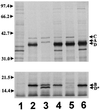Identification and characterization of a gene cluster for synthesis of the polyketide antibiotic 2,4-diacetylphloroglucinol from Pseudomonas fluorescens Q2-87
- PMID: 10322017
- PMCID: PMC93771
- DOI: 10.1128/JB.181.10.3155-3163.1999
Identification and characterization of a gene cluster for synthesis of the polyketide antibiotic 2,4-diacetylphloroglucinol from Pseudomonas fluorescens Q2-87
Abstract
The polyketide metabolite 2,4-diacetylphloroglucinol (2,4-DAPG) is produced by many strains of fluorescent Pseudomonas spp. with biocontrol activity against soilborne fungal plant pathogens. Genes required for 2,4-DAPG synthesis by P. fluorescens Q2-87 are encoded by a 6.5-kb fragment of genomic DNA that can transfer production of 2,4-DAPG to 2,4-DAPG-nonproducing recipient Pseudomonas strains. In this study the nucleotide sequence was determined for the 6.5-kb fragment and flanking regions of genomic DNA from strain Q2-87. Six open reading frames were identified, four of which (phlACBD) comprise an operon that includes a set of three genes (phlACB) conserved between eubacteria and archaebacteria and a gene (phlD) encoding a polyketide synthase with homology to chalcone and stilbene synthases from plants. The biosynthetic operon is flanked on either side by phlE and phlF, which code respectively for putative efflux and regulatory (repressor) proteins. Expression in Escherichia coli of phlA, phlC, phlB, and phlD, individually or in combination, identified a novel polyketide biosynthetic pathway in which PhlD is responsible for the production of monoacetylphloroglucinol (MAPG). PhlA, PhlC, and PhlB are necessary to convert MAPG to 2,4-DAPG, and they also may function in the synthesis of MAPG.
Figures






Similar articles
-
Autoinduction of 2,4-diacetylphloroglucinol biosynthesis in the biocontrol agent Pseudomonas fluorescens CHA0 and repression by the bacterial metabolites salicylate and pyoluteorin.J Bacteriol. 2000 Mar;182(5):1215-25. doi: 10.1128/JB.182.5.1215-1225.2000. J Bacteriol. 2000. PMID: 10671440 Free PMC article.
-
Characterization of PhlG, a hydrolase that specifically degrades the antifungal compound 2,4-diacetylphloroglucinol in the biocontrol agent Pseudomonas fluorescens CHA0.Appl Environ Microbiol. 2006 Jan;72(1):418-27. doi: 10.1128/AEM.72.1.418-427.2006. Appl Environ Microbiol. 2006. PMID: 16391073 Free PMC article.
-
Posttranscriptional regulation of 2,4-diacetylphloroglucinol production by GidA and TrmE in Pseudomonas fluorescens 2P24.Appl Environ Microbiol. 2014 Jul;80(13):3972-81. doi: 10.1128/AEM.00455-14. Epub 2014 Apr 18. Appl Environ Microbiol. 2014. PMID: 24747907 Free PMC article.
-
Role of 2,4-diacetylphloroglucinol-producing fluorescent Pseudomonas spp. in the defense of plant roots.Plant Biol (Stuttg). 2007 Jan;9(1):4-20. doi: 10.1055/s-2006-924473. Epub 2006 Oct 23. Plant Biol (Stuttg). 2007. PMID: 17058178 Review.
-
Mupirocin: biosynthesis, special features and applications of an antibiotic from a gram-negative bacterium.Appl Microbiol Biotechnol. 2011 Apr;90(1):11-21. doi: 10.1007/s00253-011-3128-3. Epub 2011 Feb 20. Appl Microbiol Biotechnol. 2011. PMID: 21336932 Review.
Cited by
-
Combining in vitro and in vivo screening to identify efficient Pseudomonas biocontrol strains against the phytopathogenic bacterium Ralstonia solanacearum.Microbiologyopen. 2022 Apr;11(2):e1283. doi: 10.1002/mbo3.1283. Microbiologyopen. 2022. PMID: 35478286 Free PMC article.
-
Antibacterial pyrrolidinyl and piperidinyl substituted 2,4-diacetylphloroglucinols from Pseudomonas protegens UP46.J Antibiot (Tokyo). 2020 Nov;73(11):739-747. doi: 10.1038/s41429-020-0318-1. Epub 2020 May 21. J Antibiot (Tokyo). 2020. PMID: 32439988
-
Novel Type III Polyketide Synthases Biosynthesize Methylated Polyketides in Mycobacterium marinum.Sci Rep. 2018 Apr 25;8(1):6529. doi: 10.1038/s41598-018-24980-1. Sci Rep. 2018. PMID: 29695799 Free PMC article.
-
Improved polyketide production in C. glutamicum by preventing propionate-induced growth inhibition.Nat Metab. 2023 Jul;5(7):1127-1140. doi: 10.1038/s42255-023-00830-x. Epub 2023 Jul 13. Nat Metab. 2023. PMID: 37443355
-
Biodiversity of genes encoding anti-microbial traits within plant associated microbes.Front Plant Sci. 2015 Apr 10;6:231. doi: 10.3389/fpls.2015.00231. eCollection 2015. Front Plant Sci. 2015. PMID: 25914708 Free PMC article. Review.
References
-
- Appel R D, Bairoch A, Hochstrasser D F. A new generation of information retrieval tools for biologists: the example of the ExPASy WWW server. Trends Biochem Sci. 1994;19:258–260. - PubMed
-
- Ausubel F M, Brent R, Kingston R E, Moore D D, Seidman J G, Smith J A, Struhl K, editors. Short protocols in molecular biology. New York, N.Y: John Wiley and Sons; 1992. pp. 16.8–16.9.
-
- Bangera M G, Thomashow L S. Characterization of a genomic locus required for synthesis of the antibiotic 2,4-diacetylphloroglucinol by the biological control agent Pseudomonas fluorescens Q2-87. Mol Plant-Microbe Interact. 1996;9:83–90. - PubMed
-
- Bangera M G, Weller D M, Thomashow L S. Genetic analysis of the 2,4-diacetylphloroglucinol biosynthetic locus from Pseudomonas fluorescens Q2-87, 383–386. In: Daniels M J, Downie J A, Osbourn A E, editors. Advances in molecular genetics of plant-microbe interactions. Vol. 3. Dordrecht, The Netherlands: Kluwer Academic Publishers; 1994.
Publication types
MeSH terms
Substances
Associated data
- Actions
LinkOut - more resources
Full Text Sources
Other Literature Sources
Medical
Miscellaneous

